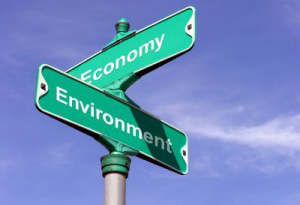|
Oil Sands Not an Economy/Environment Trade-Off |
|
by
Henry Lyatsky & Brianna Heinrichs |
|
The
shrill, endless denunciations of the “tar sands” across North America,
and indeed around the world, have largely overshadowed any
communications efforts by the oil industry to show that the oil sands
are benefiting Canadians and being developed in a responsible way.
The
oil industry needs to do a better job of explaining to everyday
Canadians what the oil sands mean to them. Much of the debate tends to
be falsely framed as “economic benefits versus a healthy environment”,
as if citizens can only choose one at the expense of the other. The
public needs to know the facts about both the economic benefits and the
environmental impact of developing this vital resource.
Indeed, the oil sands are now an indispensable driver of Canada's
economy in an uncertain economic climate. The enormous wealth and
numerous jobs created by oil sands development benefit Alberta, the
other provinces, and the country as a whole.
 In fact, according to the Canadian Association of Petroleum Producers
(CAPP), new oil-sands investment is estimated to create an additional
800,000 jobs in Canada, many of which would be outside Alberta. Oil-sands
operators would purchase over $117 billion in supplies and services from
multiple provinces over 25 years. In fact, according to the Canadian Association of Petroleum Producers
(CAPP), new oil-sands investment is estimated to create an additional
800,000 jobs in Canada, many of which would be outside Alberta. Oil-sands
operators would purchase over $117 billion in supplies and services from
multiple provinces over 25 years.
New development in the oil sands is estimated to contribute over $2.1
trillion (in 2010 dollars) to the Canadian economy over that 25-year
period. That represents about $84 billion annually. It would pay over
$750 billion in federal and provincial taxes and royalties that finance
public services for all Canadians, such as health care and education.
Importantly, green activists consistently remind Canadians that the
health of the environment and the well-being of communities where
development takes place cannot be forgotten in the pursuit of economic
rewards. Unfortunately, much of what is said about the oil sands is
deceptive, fear-mongering, or just plain false.
For example, some “Stop the Tar Sands” posters show red splatters over
much of Alberta, giving the impression of blood or danger. The shape of
the splatters corresponds to the geographic spread of the oil sands. Although the slogan is absurd because one cannot stop the oil sands from
existing, activists are pretending that this vast area―the extent
of all deposits―would presumably be devastated by oil sands production.
|
|
“Canadians cannot afford to have pseudo-green extremists prevent
the development of the oil sands through dishonest and exaggerated
propaganda.” |
|
The anti-oil sands propaganda is catchy and haunting, but according to
CAPP, only 20% of actual reserves are close enough to the surface to be
strip-mined economically. In fact, just 3% of the total oil sands
surface area is minable, and only a fraction of that is being dug up. And even in that small plot, the land is restored to
an almost pristine
state after mining operations are finished.
Elsewhere, production uses steam-assisted gravity drainage, with much
less environmental impact because it involves no mining at all. Instead, hot steam is pumped into the formation to loosen the viscous
bitumen, which can then be extracted from a well.
Greenpeace claims the “tar sands are what unrestrained fossil fuel use
and unchecked greenhouse gas emissions look like. They are pushing us
towards runaway climate change.”
Nonsense. Canada only generates about 2% of global greenhouse gases―remarkable for a cold climate and the second largest country in the
world by landmass. Of that tiny amount, only 7.8% comes from the oil
sands. That's a negligible 0.16% of the global total!
By comparison, the increase in global greenhouse-gas emissions in 2012
is estimated by the Global Carbon Project to have been more than 16
times greater than the oil sands' total emissions, largely due to inefficient industrial expansion in China.
The public is told that oil-sands operations need a vast amount of
water. True, the oil sands used approximately 158 million cubic meters
of water in 2011, but, according to CAPP, the city of Toronto alone
consumes over twice as much. In addition, some 80-95% of the water used
in the oil sands is recycled and used again.
The oil companies know that green activists, governments, and the
general public are scrutinizing their operations, and they make sure
that their
environmental footprint is controlled and reduced every day. They are
not “unrestrained.”
Like
any oil development, the oil sands mean indispensable fuel to power our
way of life, and they provide vast economic opportunity and numerous
jobs. Canadians cannot afford to have pseudo-green extremists prevent
the development of the oil sands through dishonest and exaggerated
propaganda.
|
|
 |
|
First written appearance of the
word 'liberty,' circa 2300 B.C. |
|
Le Québécois Libre
Promoting individual liberty, free markets and voluntary
cooperation since 1998.
|
|

